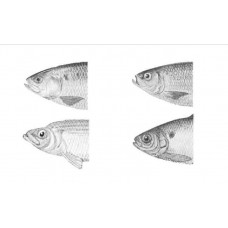Latin name
Clupea
Other names
American Shad, Atlantic Herring, Alewife, Threadfin Shad
Identification
Body compressed from the sides, with jagged edge of abdomen. Scales moderate or large, rarely small. Upper jaw not protruding from lower jaw. The mouth is moderate. Teeth, if present, rudimentary and protruding. The anal fin is of moderate length and has less than 80 rays. The dorsal fin is located above the pelvic fins. The caudal fin is bifurcated.
Distribution
Herring are found in all seas except the bitterly cold waters of the Arctic and Antarctic.
Habitat
Most members of the herring family are marine. Some of them are anadromous and spawn in fresh water, and some species that are of freshwater origin stay out at sea. Herring usually move in vast schools. In the ocean, such schools can extend for many miles, making it possible to harvest fish in large quantities.
Size
Herring can live up to 20-25 years, but it is rare to find fish of this age nowadays. The ongoing active industrial fishing significantly reduces the life span of herring. The maximum length is 46 cm and weighs about 2 kg.
Life history and Behavior
No information
Food and feeding habits
Herring feed on plankton, sifting their food through their numerous gill covers. They are used as bait, pieces or whole, by anglers for various types of game.
Reproduction
No information
| Classification | |
| Phylum | Chordata |
| Class | Actinopterygii |
| Squad | Clupeiformes |
| Family | Clupeidae |
| Genus | Clupea |
| Species | C. harengus |
| Features | |
| Conservation status | Least Concern |
| Habitat | Pelagic |
| Life span, years | 16 |
| Maximum body weight, kg | 1.1 |
| Maximum length, cm | 45 |
| Sailing speed, m/s | No information |
| Threat to people | Edible |
| Way of eating | Planktonophage |
Herring
Tags: Herring

